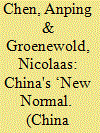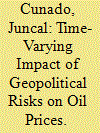|
|
|
Sort Order |
|
|
|
Items / Page
|
|
|
|
|
|
|
| Srl | Item |
| 1 |
ID:
170339


|
|
|
|
|
| Summary/Abstract |
China's ‘New Normal’ has been much discussed in recent years. An important aspect of the New Normal is the growth slowdown from levels of around 10% per annum to a more modest 6 or 7%. Not surprisingly, there has been widespread discussion of whether the slowdown is permanent or not and, in either case, what the sources of the slowdown are. However, much of this discussion has been based on informal analysis of the data rather than formal econometric results. We make a move in the direction of formal empirical analysis of this issue by estimating and simulating a vector autoregressive (VAR) model which distinguishes between demand, supply and foreign shocks as possible drivers of changes in economic growth. We analyse both two-variable (growth and inflation) and three-variable (foreign growth, domestic growth and inflation) VAR models and identify demand, supply and foreign shocks, using a modification of the Blanchard-Quah identification procedure. In the two-variable model we identify two shocks (demand and supply) and find that the slowdown since the GFC has been mainly supply-driven. This conclusion is not changed when a foreign growth variable is added to the model and a foreign shock is allowed for – we find that demand continues to be of relatively little importance, that the foreign shock also makes little contribution to explaining the long-run growth decline in China which continues to be driven by long-term supply factors. This conclusion is robust to a number of alternative formulations of the model. Thus, the growth slowdown may, indeed, be characterised as the ‘New Normal’.
|
|
|
|
|
|
|
|
|
|
|
|
|
|
|
|
| 2 |
ID:
174615


|
|
|
|
|
| Summary/Abstract |
This paper analyses the dynamic impact of geopolitical risks (GPRs) on real oil returns for the period February 1974 to August 2017, using a time-varying parameter structural vector autoregressive (TVP-SVAR) model. Besides the two variables of concern, the model also includes growth in world oil production, global economic activity (to capture oil-demand), and world stock returns. We show that GPRs (based on a tally of newspaper articles covering geopolitical tensions), in general, has a significant negative impact on oil returns, primarily due to the decline in oil demand captured by the global economic activity. Our results, thus, highlight the risk of associating all GPRs with oil supply shocks driven by geopolitical tensions in the Middle East, and hence, ending up suggesting that higher GPRs drive up oil prices.
|
|
|
|
|
|
|
|
|
|
|
|
|
|
|
|
|
|
|
|
|